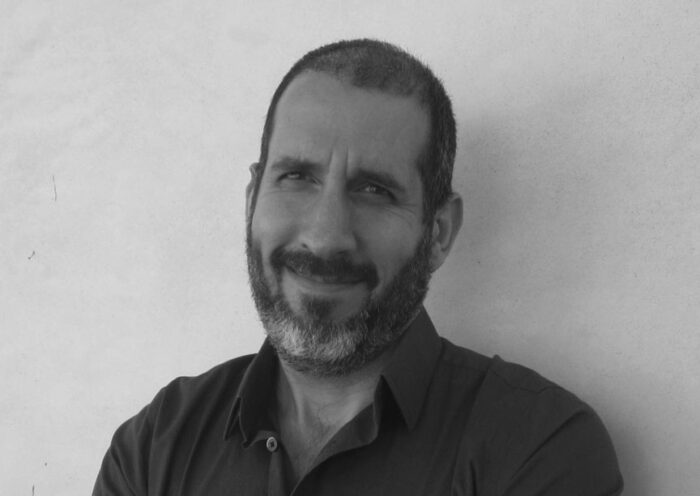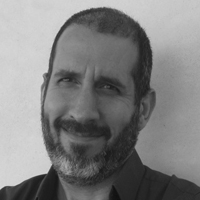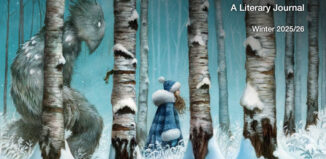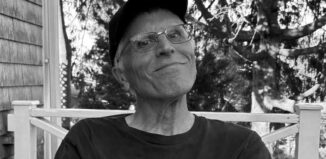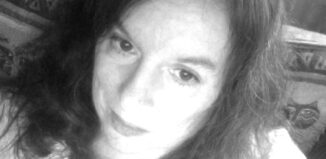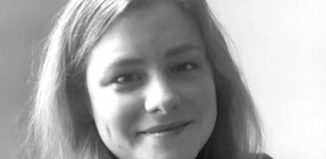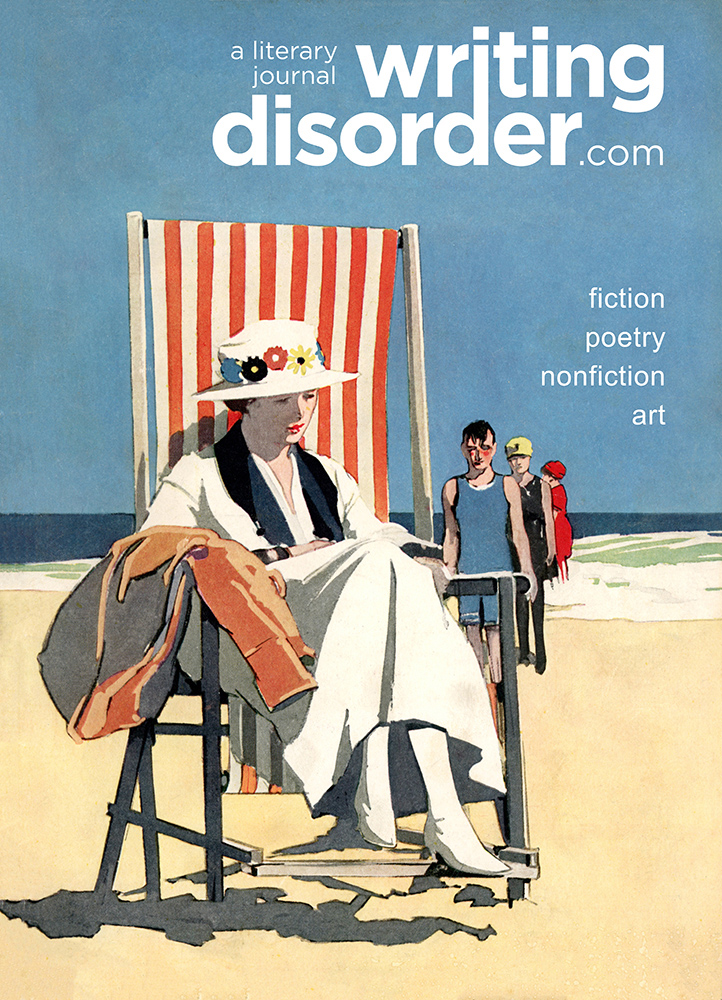Homeomorphism
by Erik Harper Klass
1
A cold wind. Rain threatening (distant fallstreaks). A two-story building of weathered bricks and arched windows. A little door on the left under a blue awning. On the awning’s scalloped valance, a single word in faint, faded, white majuscular letters: fortune.
A man, a soldier, back from a war. Walking and then stopping and then, on this day, feeling he had nothing much to lose, entering.
The room: windowless, dark, tapestries on walls. In the room’s center, a round table draped with a cloth of no apparent color. A single candle in a candleholder with a green frustum-shaped shade. Two old chairs with turnings placed on opposite sides of the table, as if set for a game of chess. And sitting on one of the chairs, facing the man, who stood motionless at the room’s threshold: a woman.
The woman: Not old, not young. Hair pulled back like (he thought, in an instant) de La Tour’s Magdalene. Bracelets on both wrists that glimmered and sounded like tiny bells. Eyes that, at a glance, seemed both everchanging and constant, like (he thought (he had a literary mind)) forge fires. And then, as if in response to his gaze (for he stood there looking), she leaned back into the darkness and he could no longer see her eyes. She spread her hands out, as if to show she were unarmed, and then her hands disappeared beneath the table. He imagined them resting in her lap, like nesting, nestling birds. She gestured with her head for him to sit. The door closed behind him. She may have been beautiful.
“You are sad,” she said.
His answer: nothing at all. There was no question. He was sitting now.
Behind the woman, and a bit to her left (his right): a tall cabinet vitrine, with two glass doors, in which the man could see the following: the back of the woman’s left shoulder, a candle flickering beneath a green frustum-shaped shade, a man staring into the two glass doors of a tall cabinet vitrine. She asked him to close his eyes and put out his hands. He heard the vitrine open, the sound of movement, the rustling of silk. And then he felt the weight of, and curled his fingers around, an object.
“An hourglass,” he said right away, as if this were a game of speed.
“Not what it is,” she replied. “What it represents. What it means.”
The man began to open his eyes but she asked him to keep them closed (it is not clear how she knew his eyes were opening). He ran his fingers over the object. Glass. Wood. Three metallic posts—spindles they are called—equally spaced circumferentially.
“An hourglass could mean time passing,” he said.
“Yes,” she said, probably nodding.
“Or time past, or sand, or a place where hourglasses are made.”
“Yes,” she said. He could hear a smile in her reply.
Filling the room: a silence. He turned the object in his hands.
“Perhaps I am out of time,” he said. “Or time is nothing at all, an illusion, merely the consequence of the chronological accretion of my memories. Or perhaps I am in prison, as is the sand within the object (I assume the object is filled with sand),” he said, shaking the hourglass and holding it up to his right ear, as one might shake a gift before opening it.
“Good,” she said.
He kept his eyes closed, again turned the object, ran his hands along its topography, its declivities and protrusions.
“Perhaps it is her,” he said, “perhaps her body.”
She did not reply.
“Perhaps the hourglass is loss.”
“You have lost her?”
“I have lost her, yes,” he said. “She has left. I don’t blame her for leaving.”
She waited. The clockwork of the universe advanced inexorably, while inexorably the clockwork of the hourglass did not. And then she invited him to open his eyes. She reached out with extremely long arms and reclaimed the object. Yes it was an hourglass: glass and wood, three vertical spindles constructed of brass. He felt strangely guilty looking at it, found himself looking away. The woman returned it to the darkness of the vitrine.
“That is all for today,” she said.
The man rose and said goodbye and, without paying, without another word, left the room and entered the wind and rain (it had indeed begun to rain). There was, it seems, an unspoken understanding that he would return.
2
She said to him on his second visit: “There is a field of mathematics called topology, which involves the exploration of the properties of objects that in fundamental ways do not change when these objects are twisted or deformed, a transformation we call homeomorphism. The most common object used to illustrate this transformation is a doughnut (a torus shape)—for convenience, please imagine an uncooked doughnut. (There is nothing new about any of this,” she said. “You have likely heard all of this before. I am not trying to impress you.) We might take this doughnut and, in the words of the mathematicians, ‘continuously deform’ the object into the shape of a coffee mug. Try to imagine this. The space within the mug’s handle was once the doughnut’s hole, and the cup itself was once the doughnut’s body (imagine forming the cup by depressing the doughnut’s dough with your thumbs—carefully, carefully). The doughnut and the coffee mug are, mathematically speaking, indistinguishable. As abstract spaces, they are topologically identical. This is sometimes called the torus and mug morphology,” she said.
3
“Freud,” she said, “described a time when an infant experiences what he called an ‘oceanic feeling,’ in which the infant has not yet developed an awareness of the shape and limits of its body, and is thus completely at one with the universe.”
She said this, among other things, on his third visit. This, this oceanic feeling, was not one the man could remember or hope for or even begin to imagine.
4
On the forth visit she once again asked the man to close his eyes, and she reached into the vitrine and pulled forth an object, set it in his hands. This was by now already a ritual of theirs. He accepted the object as the poor accept their alms.
“Can one without sight recreate an object, discovered only by touch, graphically on a white page?” she asked.
He turned the object over in his hands. A key, definitely a key, a giant key, brass perhaps, attached to . . . attached to a wooden fruit . . . a pear, yes a pear.
“Before you on the table,” she said,” is a malleable plastic surface which will be our proverbial white page.”
He nodded, he had seen this when he arrived, a flat white rectangle, his eyes remained closed. He patted the table to his right and found a kind of stylus in the exact place where he remembered seeing a kind of stylus. She did not speak. He drew. His right hand (the hand holding the stylus) moved. His left hand (the hand holding the giant key attached to a pear) moved. And while he drew, he thought of this woman before him in the darkness. He thought of her face. He thought of her eyes, which he felt in some strange way he had not yet really seen. They, these features of the woman, were but ideas of sensations, atmospheres, air. And then, as he drew this giant key attached to a wooden pear, he thought without meaning to (as was always the case) of a long straight road running unsheltered through a desert without shadows. He thought of a flash of light and sound. And then, silence. He thought of a helicopter and a bright white room and then another room and then a third room—only three rooms, but he could barely keep track—a room of incongruous congruent mirrors. When he was done drawing he put down the stylus with a hand that trembled.
She spoke: “So how do shapes and their surfaces speak to the mind? We know from past experiments that both the sighted and the blind represent the edges of surfaces—places where objects overlap, or places of meeting, of rupture, of collision—with lines, and, furthermore, we know that both the sighted and the blind take a specific vantage point to portray the objects of inquiry. Note that neither the overlap of these objects, nor these places of meeting or rupture, must be perceived with vision. Both can be experienced with the hands, by touch.”
He opened his eyes. He looked at the giant key attached to a wooden pear. Turned his head. Looked at the giant key attached to a wooden pear. His drawing was excellent.
5
Each time he came he worried that she would not be there, that she had never been there, that none of this was real, and somehow the accumulation of their meetings—they had somehow settled on weekly meetings, Fridays, just as the sun set at the very end of the street in bursts of red and orange between the silhouetted, linear array of equidistant plane trees—did nothing to dispel the uncertain nature of it all.
6
“I read somewhere,” he said to her on his sixth visit, “in an old book, when I was healing, in that room of mirrors, once I had regained the capacity for thinking, that some people, ‘whose minds are prone to mystery,’ believe that the objects of our contemplation, the objects themselves, are changed somehow when they are perceived. So when we see a painting, a monument, a tree, a lover’s face, we see not the object at all but rather a veil or membrane of forces and impressions—I believe this is how it was written—distorting the object, coloring it in some way. The pale-blue domes of a mosque encircled by white doves, the curving trace of a purple canyon, the sunlit, jagged architecture of a conquered city—all of these things are changed slightly, imperceptibly perhaps, by all the thousands and millions of people who have already seen them.” He stopped and reached for a glass of water that in fact was not there. “I suppose,” he continued, “if we consider this theory carefully, we discover that every time we see an object, we are met not with the object itself, but rather with the residue of all the eyes that have come before us.”
He played his hand over his cheeks, as if he were smoothing down a beard. She did not speak.
“Have you ever wished you did not have eyes?” he asked, apropos of everything.
Her reply: “There is a school of Ancient Greek philosophy called Eleaticism, which teaches, among other things, that the only certain science is that which places no dependence or importance whatsoever on the senses, and all to reason.”
And then she drifted back into the darkness.
7
On his seventh meeting with the woman, the man was presented with the challenge—the possibly impossible challenge—of arranging a collection of heterogeneous objects into some coherent pattern. From the vitrine, she, like a child showing off her toys, pulled out and presented to the man, his eyes closed as usual, many objects:
- a matryoshka doll: collapsed, smooth, rattling;
- a stone of course grain;
- an ashtray shaped like a heart;
- a nautilus;
- a bottle, globular;
- a huge china vase with some design—dragons? flowers?—in bas-relief (he reached his hand inside the object, a disturbingly rough surface, and felt the design approximated in reverse);
- a book with raised lettering on the cover (difficult to determine with fingers) marked by a heavy moiré silk ribbon (it would turn out to be an old volume of a book by Proust);
- after a moment: a spirit level;
- a mechanical lion that could walk several steps, and then, when a button was pressed, the lion’s breast would open and reveal a bouquet of flowers (lilies, for all he knew);
- a hobnail mustache cup (not to be confused with a shaving mug, which is a very different object);
- a shining metal cone, of the diameter of a die, that he found intolerably heavy;
- a sprig of straw or suchlike;
- a monocle (or a small magnifying glass with the handle broken off);
- an embarrassing toy coffin in which the corpse has a spring-loaded erect phallus that pops up when the lid is removed (did she smile as he touched this object, as he held, indeed even stroked, the phallus (for just a moment!) with the tips of his thumb and index finger?);
- a runcible spoon;
- a (the?) huge key attached to a wooden pear;
- a pop-up book created for blind children who cannot yet read braille. The book, as far as he could tell (he turned the pages with his eyes tightly closed), recounts the following story: The setting is a small village. A young man falls in love with a young woman—to be sure, an unrequited love. She is the most beautiful woman in this village: the way she laughs, the way she smiles, the way she moves her hair from her eyes when the wind blows. The young man does not imagine that the young woman could ever return his love. To put it ineloquently but succinctly: she is out of his league. The story continues. One spring day, walking forlornly down a floriferous path in the hills, the young man comes upon an old man attempting to pull a hand cart across a stream (the narrative does not explain the reasoning for the old man’s arduous path). The young man, as we can imagine (for he has been presented as a benevolent and kind young man), helps the old man pull the cart—the reader “sees” an image of the young man, up to his knees in the rushing stream, trousers rolled up, shoes tied and hanging from a shoulder, straining with the cart’s weight. After the crossing the old man reaches out with both bony hands and touches the young man’s face, running his hands down the young man’s cheeks, as if the old man were smoothing down the young man’s (nonexistent) beard. The young man is too startled to back away, to respond at all. And then the old man turns and ambles off with his cart into the shadows of trees. The young man is left bewildered by the old man’s touch. There is something extraordinary about it, something akin to the feeling of waking from a dream, or falling into one. He sits down on a rock at the edge of the stream. He picks up stones and tosses them absentmindedly. He observes the way the trees, mostly fir trees, take on the color of the sun as it sets (this is all done with textures, with differences in smoothness and roughness on the page). He listens to the songs of birds (various notes in high relief on a swirling staff), and he wonders, in a moment of digression, what aspect of these songs is most important for attracting mates: pitch or rhythm, or perhaps it is something else, some fine structure that goes beyond what human hearing can discern (and he is reminded, in this extended moment of digression, of the importance of the sound of prose; we should listen to the words, he thinks, as if we were birds (all of this—his thoughts, etc.—is made clear by the textural “images” on the page)). And then, for no apparent reason the young man can recall, he leans over and observes his reflection in the water. A miracle! A transformation! He is beautiful! Subsequent events are not hard for the well-read reader to anticipate. The young man returns to the village. One thing leads to another (one may turn the pages quickly now), and the young man and the young woman fall in love. They walk hand in hand through fields, they kiss in a floriferous park with wind-tossed trees, they hold each other’s bodies close and dance (more notes across the page), they lie together (probably naked, but concealed beneath blankets) in a room lit by candles, etc. They eventually marry. The story continues, and the reader is led to understand that time has passed. The reader (that is, the feeler) learns that the young man, over the course of events, has become rich. He is a writer, apparently a great writer, and the people of the village pay him for his craft (an outlandish thought!), and, additionally, he has received several lucrative grants from various foundations and fellowships. The reader (feeler) turns the page and now the young man is on his way to a reading of a recent short of his that had been published in a prestigious literary journal, the reading taking place at a university to which he is running late, and along the same floriferous path mentioned above he comes across the same old man with the same hand cart at the same stream (what are the odds?), the latter trying—and, once again, failing—to make a crossing. This time the young man walks quickly past. He has no time to help the old man. (By now the reader (that is, the feeler) knows where this is going. Everything is as clear as day, so to speak. These stories have been written since time immemorial. Every story tells a story already told. Even the young man on the page knows this well.) Time, once again, passes, and the young man returns from what was, in his estimation, an excellent, well-received reading, after which he had answered various questions related to the author’s “method” and “craft,” in an erudite and often agreeably enigmatic manner, much to the pleasure of all in attendance. He returns to his home and enters. He sets down his writer’s satchel. He goes to greet his wife with a kiss, as per usual. She turns to him. And as his face approaches hers, she recoils. She decides—in a flash, in a second, which is how it sometimes goes with these things—that she no longer loves him. Yes the decision is hasty, but it is as if she has felt this way for a long time, as if this seed of their dissolution had been planted long ago and only now has broken the soil and begun to blossom—rapidly, floriferously. The reader sees (feels) their hands separating. The reader sees (feels) her packing her things. The reader sees (feels) her drifting off into a rain-streaked distance. On the last page of the book the reader sees (feels) the young man—no longer, in truth, so young—standing alone, in an atmosphere of blue melancholy (the reader’s (feeler’s) fingertips seemingly convey to the reader’s (feeler’s) brain a tactile transcription of the prismatic specter). And then, as the reader closes the book, the disfigured young man folds up and collapses into the flat emptiness of his eternal imprisonment;
- the carapace of a hawksbill turtle;
- and a dress; he imagines—he is not sure why—a floral print, with eight buttons down the front (or perhaps the back).
But how to arrange these object? Color is out of the question. Perhaps by size (small to large)? By weight (light to heavy)? By softness to hardness? By smoothness to roughness? By fragmentation to solidity? By shape (roundness to angularity)? By sound (those objects that rattle when shaken to those that do not)? The man finds that no sooner has he settled on one methodology than his criteria becomes unstable and his groupings become precarious, and he feels compelled to go back and try again, splitting up objects that are nearly the same, superimposing different criteria, frenziedly beginning all over again, becoming more and more disturbed, and teetering finally on the brink of anxiety.
If there is a lesson to the exercise, the woman has not made it clear, she will never make it clear. But there is a lesson. Of course there is a lesson.
8
And on their eighth meeting he sat before her at the table, and she explained to him about a special kind of line called a “long line” (or “Alexandroff line”), which she defined as “a topological space, something like a regular (or ‘real’) line, but much longer. (Furthermore,” she explained, parenthetically, “the long line is not a Lindelöf space, is not second countable, is not metrizable, is not paracompact, and is not normal.) We may think of a real line as having a countable number of line segments. The long line, however,” she continued, “has an uncountable number of such segments. When the distance between a man and the object of his desire is a real line, the man may traverse the line, he may—if he is diligent, if he is tireless, if he is lucky—find his prize (imagine a point on the line) waiting for him, in all her punctiform perfection. A long line, however,” she continued, “cannot be traversed. The desired object cannot be reached, cannot be touched. The man who is separated from his lover by a long line will suffer, yes, but he will eventually forget about her, for when any distance is discovered to be unbridgeable, this distance, over time—ironically perhaps—collapses and eventually disappears.”
“That all sounds very profound,” the man replied, rubbing his temples. Truth be told, his mind, around the word “metrizable,” had wandered and settled on more tangible considerations, such as the simple and strangely soothing sound of the woman’s voice (that is, form, sans content).
She leaned back, once again, as always, from darkness into deeper darkness, and, barely perceptibly, smiled. “All too often one judges something to be profound when in fact one has merely failed to grasp it. Perhaps the ‘long line’ is a figment of my imagination. Perhaps what I tell you is gibberish. Perhaps I know nothing at all.”
9
On his ninth visit she placed a Rubin’s vase, approximately the size of a human head, before him on the table and invited him to feel it with both hands, as if he were spinning pottery.
“Tell me,” she said, “do you feel the concavities and convexities of the contours of the vase, which is to say, do you feel the vase itself?”
He ran his hands over the vase’s surface.
“Or,” she continued, “do you feel the athwart faces of two lovers, peering at each other from across an empty chasm, always, forever, just a few inches apart?”
He moved his hands for a while longer, and then he placed them face down on the table, as if he were about to be interrogated, and he said, without the slightest doubt: “The latter.”
10
On his tenth visit the woman told the man the following story (this is what they would sometimes do: this, in truth, is what we all do: tell stories): “St. Brigid once, it has been said,” she said, “performed the miracle of giving a blind woman the gift of sight. But for an instant. Only an instant. The ‘blind’ woman, if I may embellish a bit, saw spreading fields of unimaginable colors—cinnabar, saffron, xanthic, celadon, cyan—upon which cattle grazed, each animal frozen in time. She saw scattered clouds in the sky, in the exact shape—she thought, in this instant—of cattle grazing upon fields. She saw the gentle outline of distant hills (puce, violescent). She saw a hawk disappearing into the sun, to become one with the sun, to never leave the sun. She saw orchards of apple and plum trees, and the long shadows of orchards of apple and plum trees. She saw St. Brigid’s face, beautiful, a framing white veil, one single unruly strand of auburn hair coming loose (could this be?), a cross hanging from a black cord below her chin. What I have described includes perhaps a millionth of a millionth of a percent of a percent of what the woman saw. The woman,” the woman continued, “found this scene so beautiful, so vivid, that this instant of sight was enough. The memory of her sensations (for memory is what, less than a second later, as she returned to blindness, these sensations had already become) lingered with the reverberations and recurrences of these colors and objects, would illuminate her mind and thoughts, for the remainder of her days.”
11
On his eleventh visit the woman said: “Some believe that we are able to remember everything that happens to us, everything, in fact, that is happening anywhere in the universe, down to the smallest detail. Each winding silver-gray arabesque of the candle smoke, each spinning fleck of dust, the sound of a mountain settling, every word spoken, even the echoes of another’s thoughts. We are that open, that permeable to sensations. So what our brains must do,” she continued, “according to this theory, is defend ourselves from the world around us. Our brains act merely as filters, keeping us from becoming entirely overwhelmed by what is essentially an endless and voluminous onslaught of mostly useless information. You are probably doing this now,” she said to the man. “Even these words will be lost to you, like yesterday’s clouds. Only that which is most important is taken in, is remembered.”
She paused, gathered up the hair from the back of her neck, let it fall.
She continued: “Scientists know that the sensory apparatus of single-celled organisms, however, are unfiltered. There is no distance between the sensation and the perception. There is no neural editing done by the brain, a brain which, of course, does not exist. This, you might agree,” she said, “is rather interesting, perhaps even sad, for the idea suggests that only the most rudimentary of organisms can perceive the universe as it really is.”
12
“But what does one see when one sees?” she asked on his twelfth visit to the windowless room. She handed him an amorphous fragment of what he would later discover to be garnet-red glass—for now, it was just an amorphous fragment of probably glass. “If you observe this object, any object, microscopically,” she continued, “you would see—or perhaps the better word is discover—that nothing is continuous, nothing is homogenous. Everything is granular. The sea, a cow, a sea cow, the amorphous fragment of glass in your hand, your hand—everything is made of collections of invisible particles, vibrating, spinning, mostly air.
“Love,” she said, “is no less tenuous.”
13
On his thirteenth visit the man said: “Someone—a nurse, with a beautiful voice that cracked at the ends of phrases—would read to me from time to time in my endless days in the room of mirrors. Once she read to me a story of a philosopher. German, I believe. I forget who exactly. A first name last name. The story, I will always remember, was about the philosopher’s socks.” The man laughed almost silently before continuing. “The philosopher recalls opening a drawer—he was just a child at the time—and discovering his socks, which his mother had rolled up in pairs and turned inside out in the usual manner. He described them as pockets. He would reach his hand into each one, as far as he could, finding great pleasure in the experience. Why would he do this? Why this pleasure? It was not for warmth or texture or feelings of possession or any sense of organizing principles or modes of production (I think the philosopher was a Marxist) or maternal love or sexual desire or whatever else we might come up with. It was simply for what he described as the ‘little present’ held within. And then, once he had established the existence of each of these little presents, held tightly in his fist, he would begin a new phase: the unfolding, the unveiling. There was a similar pleasure in this, but it also came with something he found disquieting: for each time he pulled from a rolled up sock its gift, he found that the pocket—which of course was formed of the substance of the present itself—would cease to be. And yet the philosopher remembers repeating this childhood experiment again and again.”
He sat in the room at the table before the woman, thinking about the story of the philosopher and the philosopher’s socks, but really thinking of the nurse and her voice and the room of mirrors.
He continued: “It took me a while, but I guess the story is about desire, about how the object one desires disappears at the moment of its attainment.”
After a moment of silence in the dark room, she spoke: “Desire is paradoxical, yes? The very object desire seeks to obtain, it also seeks to consume, and in the process it consumes itself. But one can imagine,” she continued, “or really imagine imagining, a perfect object, an object disentangled from all desire. The perfect object can be at once held and withheld.”
“I would like that,” he said, not at all sure what this perfect object might be, but understanding that this—this search—was why he was here.
14
She said on their fourteenth visit (but at this point who was counting?): “The story of the philosopher and his socks also exemplifies the unity of form and content, their consummation, their consubstantiation, their homoousianism.”
“You and your words,” he said, half laughing, half frowning.
15
She said: “Other examples of homeomorphism: A circle and a square. A hand and a soul. A woman’s hair spread out on your shoulder and the geometrical mapping of the shape of time. Silence and the sound of a bomb. A wounding and a healing. The loss of all love—and its commencement.”
16
And then finally: A warm wind. A red-orange sun. Equidistant plane trees. A man, a wounded soldier, back from a war. He stood before the two-story building of weathered bricks and arched windows, his long shadow stretching out to the east like a Giacometti statue. The little door. The awning flapping in a rising wind, the sound like someone lightly slapping skin. He waited to enter, on this day when he had everything to lose. The sun sank infinitesimally. Lines of clouds like whale ribs, each painted pink on one side, drifted across the darkening sky. And into mirrored rooms, into wombs of smoke, into darkness, we sometimes hasten our rebirths.
Afterword
I have, here and there, embellished, I have added words and phrases, occasionally changed the order of events, made educated guesses, filled in gaps, but the above describes, in more exactitude than the reader might believe, my first few months of meetings with the fortuneteller Gilberte. This is, to a large extent, how we spoke. The majority of the objects mentioned are genuine and are still sitting behind glass in her cabinet vitrine downstairs, or occasionally, I am sure, removed and presented to her clients. But memory, of course, is imprecise. I have done my best, but I’ve decided to call the above work fiction, if for no other reason than that the moniker has allowed me to include the pop-up book described in my seventh visit, a book that is, I admit, entirely fabricated.
I suppose one (other) aspect of my—let’s call it—“story” that is misleading is the timing of our love. I had fallen for her instantly. It was love at first sight (so to speak). Gilberte claims to have felt similarly. She told me that she knew, that she fell in love, the moment I quoted Calvino at our first meeting. I’ll take her at her word.
Gilberte was not born blind, but she lost her sight when she was so young that she now claims that she “no longer remembers what seeing ‘means.’ The idea of seeing, the whole concept of objects becoming upside down images in the eyes, turning into electrical signals, becoming reconstructed by our neurons into upside down upside down images in our brains that perhaps (or perhaps not) reflect, so to speak, the images of the objects so reflected, makes sense to me conceptually. But not practically. The images I imagine are completely divorced from those I ‘see’ with my other senses. They are entirely my own. I dream, I guess you could say, waking.”
As is often the case, her words elude me.
The bombing I’ve alluded to above occurred in the northern Parwan province of Afghanistan in the early spring of 2019. Three Marines and an Afghan contractor died in the attack: Cpl. Lex Boone, 22, of Salt Lake City, Utah; Sgt. Michael Parry, 23, of Sacramento, California; Staff Sgt. Lenny Cade, 41, of Chicago, Illinois; and Abdul Khan, 22, of Kabul. Two other trailing (obviously trailing) vehicles in the convoy survived, and I owe the nine accompanying service members with my life.
Gilberte and I are engaged to be married, as I write this. She is the answer to all of my prayers.
BIO
Erik Harper Klass has published stories and essays in a variety of journals, including New England Review, South Carolina Review, Yemassee (Cola Literary Review), Summerset Review, Slippery Elm, and Blood Orange Review, and he has been nominated for multiple Pushcart Prizes. His novella Polish Poets in Beds with Girls is now available from Buttonhook Press. He writes in Los Angeles, CA.
Notes
“An hourglass could mean time passing . . . a place where hourglasses are made”: See Italo Calvino, Invisible Cities, trans. William Weaver (New York: Harcourt Inc., 1974), 38.
‘oceanic feeling’: See Sigmund Freud, Civilization and Its Discontents (1930), trans. James Strachey (New York: W. W. Norton & Company, 2005), 47 and passim.
huge key attached to a wooden pear: See W.G. Sebald, The Rings of Saturn, trans. Michael Hulse (New York: New Directions, 1998), 43.
‘whose minds are prone to mystery’: Marcel Proust, In Search of Lost Time: Volume VI: Time Regained (1927), trans. C. K. Scott Moncrieff and Terrence Kilmartin (New York: The Modern Library, 2003), 283.
a tactile transcription of the prismatic specter: Vladimir Nabokov, Ada, Or Ardor: A Family Chronicle (1969) (New York: Vintage Books, 1990), 469.
a shining metal cone, of the diameter of a die: Jorge Luis Borges, “Tlön, Uqbar, Orbis Tertius” (1940), trans. Alastair Reid, in Ficciones (New York: Grove Wiedenfeld, 1962), 33.
superimposing different criteria . . . teetering finally on the brink of anxiety: Michel Foucault, preface to The Order of Things: An Archaeology of the Human Sciences (1966), trans. Alan Sheridan (New York: Vintage Books, 1994), xviii.
the philosopher’s socks: For more on Walter Benjamin’s socks, see Walter Benjamin: Selected Writings, vol. 3,ed. Marcus Bullock and Michael W. Jennings, trans. Howard Eiland (Cambridge, Mass.: The Belknap Press of Harvard Univ. Press, 1996), 374.

